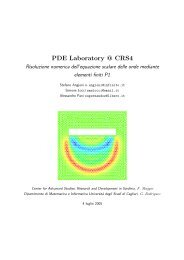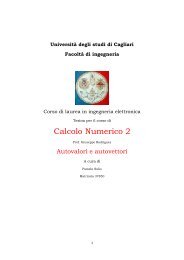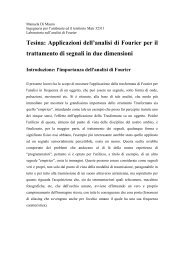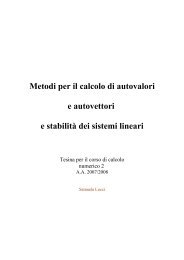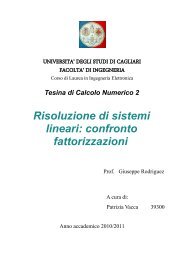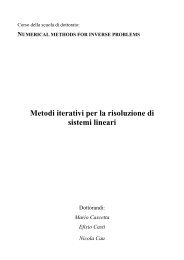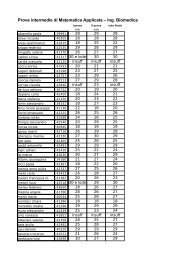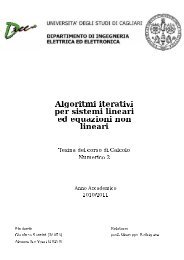TRASFORMATA DI FOURIER E LE FUNZIONI ARMONICHE
TRASFORMATA DI FOURIER E LE FUNZIONI ARMONICHE
TRASFORMATA DI FOURIER E LE FUNZIONI ARMONICHE
You also want an ePaper? Increase the reach of your titles
YUMPU automatically turns print PDFs into web optimized ePapers that Google loves.
(d) Traslazione della trasformata di Fourier. Se f ∈ S ′ , si haF [f](ξ + ξ 0 ) = F [e i(ξ 0,x) f](ξ).Infatti, utilizzando la formula (I.25), si ottiene per tutte le ϕ ∈ SF [f](ξ + ξ 0 ), ϕ) = (F [f], ϕ(ξ − ξ 0 )) = (f, F [ϕ(ξ − ξ 0 )])= (f, e i(ξ 0,x) F [ϕ]) = (e i(ξ 0,x) f, F [ϕ]) = (F [e i(ξ 0,x) f], ϕ),da cui segue la formula (I.26).(I.26)(e) Trasformata di Fourier di similitudine (con riflessione). Sef ∈ S ′ , per tutti i valori reali di c ≠ 0 si haF [f(cx)](ξ) = 1 ( ) ξ|c| F [f] , (I.27)n cpoichè per tutte le ϕ ∈ S abbiamo(F [f(cx)], ϕ) = (f(cx), F [ϕ]) = 1= 1 ( ∫f,|c| n)ϕ(ξ)e i( x c ,ξ) dξ= (F [f], ϕ(cξ)) = 1|c| n (F [f]( ( x))f, F [ϕ]|c| n c∫= (f, ϕ(cξ ′ )e i(x,ξ′) dξ ′ ) = (f, F [ϕ(cξ)])( ) ) ξ, ϕ .c(f) Trasformata di Fourier del prodotto diretto. Se f ∈ S ′ (R n ) eg ∈ S ′ (R m ), si haF [f(x)·g(y)] = F x [f(x)·F [g](η)] = F y [F [f](ξ)·g(y)] = F [f](ξ)·F [g](η).(I.28)Infatti, per tutte le ϕ(ξ, η) ∈ S(R n+m ) abbiamo(F [f(x) · g(y)], ϕ) = (f(x) · g(y), F [ϕ])= (f(x), (g(y), F η F ξ [ϕ])) = (f(x), (F [g], F ξ [ϕ]))= (f(x) · F [g](η), F ξ [ϕ]) = (F x [f(x) · F [g](η)], ϕ) = (F [g](η), (f(x), F ξ [ϕ]))= (F [g](η), (F [f](ξ), ϕ)) = (F [f](ξ) · F [g](η), ϕ),da cui seguono le uguaglianze (I.28).(g) Formule analoghe sono anche valide per la trasformazione di FourierF x , per esempio: se f(x, y) ∈ S ′ (R n+m ), si haD α ξ D β y F x [f] = F x [(ix) α D β y f],14F x [D α x D β y f] = (−iξ) α D β y F x [f].(I.29)





